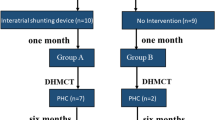Abstract
This study aimed to determine whether the Rho-kinase–mediated pathway is involved in the pathogenesis of left-to-right shunt–induced pulmonary hypertension and whether fasudil exhibits acute beneficial effects on the hemodynamics of these patients. A total of 12 patients with a mean age of 12.3 years were enrolled in a self-controlled prospective study. All the patients had a diagnosis of congenital heart disease with slight to moderate pulmonary hypertension and were scheduled for transcatheter closure. After placement of the catheters, 30 mg/kg fasudil was injected intravenously over 30 min under room air conditions. Hemodynamic parameters including pulmonary artery systolic pressure (PASP), pulmonary vascular resistance (PVR), systemic artery pressure (SAP), systemic vascular resistance (SVR), cardiac input, and blood oxygen saturation were measured and calculated at baseline and 30 min after fasudil injection. After fasudil treatment, PASP decreased to a level 33.03 ± 6.64% less than baseline value (p < 0.01), and maximal PVR decreased to a level 33.03 ± 6.64% less than baseline value (p < 0.01). Cardiac input increased to a level 7.7 ± 5.2% more than baseline value (p < 0.05), and mixed venous oxygen saturation significantly increased to a level 7.7 ± 5.2% more than baseline value (p < 0.01). The left-to-right shunt ratio (QP/QS) also tended to increase (16.2 ± 12.5% of baseline value; p < 0.01). Whereas SAP showed only a slight decrease (−1.6 ± 3.1% of baseline value; p = 0.08), SVR significantly decreased (−10.2 ± 12.2% of baseline value; p < 0.01), and the PVR/SVR ratio tended to decrease (−23.9 ± 15.1% of baseline value). In conclusion, Rho-kinase is involved in the pathogenesis of left-to-right shunt–induced pulmonary hypertension, and fasudil is a novel therapeutic approach.

Similar content being viewed by others
References
Abe K, Shimokawa H, Morikawa K et al (2004) Long-term treatment with a rho-kinase inhibitor improves monocrotaline-induced fatal pulmonary hypertension in rats. Circ Res 94:385–393
Chihara K, Amano M, Nakamura N et al (1997) Cytoskeletal rearrangements and transcriptional activation of c-fos serum response element by rho-kinase. J Biol Chem 272:25121–25127
Civelek M, Ainslie K, Garanich JS et al (2002) Smooth muscle cells contract in response to fluid flow via a Ca2+-independent signaling mechanism. J Appl Physiol 93:1907–1917
Ellerbroek SM, Wennerberg K, Burridge K (2003) Serine phosphorylation negatively regulates RhoA in vivo. J Biol Chem 278:19023–19031
Fagan KA, Oka M, Bauer NR et al (2004) Attenuation of acute hypoxic pulmonary vasoconstriction and hypoxic pulmonary hypertension in mice by inhibition of rho-kinase. Am J Physiol Lung Cell Mol Physiol 287:L656–L664
Feng J, Ito M, Ichikawa K et al (1999) Inhibitory phosphorylation site for rho-associated kinase on smooth muscle myosin phosphatase. J Biol Chem 274:37385–37390
Guilluy C, Sauzeau V, Rolli-Derkinderen M et al (2005) Inhibition of RhoA/Rho-kinase pathway is involved in the beneficial effect of sildenafil on pulmonary hypertension. Br J Pharmacol 146:1010–1018
Hall A (1998) Rho GTPases and the actin cytoskeleton. Science 279:509–514
Higashi M, Shimokawa H, Hattori T et al (2003) Long-term inhibition of rho-kinase suppresses angiotensin II-induced cardiovascular hypertrophy in rats in vivo: effect on endothelial NAD(P)H oxidase system. Circ Res 93:767–775
Ishikura K, Yamada N, Ito M et al (2006) Beneficial acute effects of rho-kinase inhibitor in patients with pulmonary arterial hypertension. Circ J 70:174–178
Katsumi A, Milanini J, Kiosses WB et al (2002) Effects of cell tension on the small GTPase rac. J Cell Biol 158:153–164
Ming XF, Viswambharan H, Barandier C et al (2002) Rho GTPase/Rho-kinase negatively regulates endothelial nitric oxide synthase phosphorylation through the inhibition of protein kinase B/Akt in human endothelial cells. Mol Cell Biol 22:8467–8477
Nagaoka T, Morio Y, Casanova N et al (2004) Rho/Rho-kinase signaling mediates increased basal pulmonary vascular tone in chronically hypoxic rats. Am J Physiol Lung Cell Mol Physiol 287:L665–L672
Narumiya S (1996) The small GTPase rho: cellular functions and signal transduction. J Biochem (Tokyo) 120:215–228
Numaguchi K, Eguchi S, Yamakawa T et al (1999) Mechanotransduction of rat aortic vascular smooth muscle cells requires RhoA and intact actin filaments. Circ Res 85:5–11
Putnam AJ, Cunningham JJ, Pillemer BB et al (2003) External mechanical strain regulates membrane targeting of rho GTPases by controlling microtubule assembly. Am J Physiol Cell Physiol 284:C627–C639
Sauzeau V, Le Jeune H, Cario-Toumaniantz C et al (2000) Cyclic GMP-dependent protein kinase signaling pathway inhibits RhoA-induced Ca2+ sensitization of contraction in vascular smooth muscle. J Biol Chem 275:21722–21729
Shimokawa H, Seto M, Katsumata N et al (1999) Rho-kinase-mediated pathway induces enhanced myosin light chain phosphorylations in a swine model of coronary artery spasm. Cardiovasc Res 43:1029–1039
Somlyo AP, Somlyo AV (2003) Ca2+ sensitivity of smooth muscle and nonmuscle myosin II: modulated by G proteins, kinases, and myosin phosphatase. Physiol Rev 83:1325–1358
Uehata M, Ishizaki T, Satoh H et al (1997) Calcium sensitization of smooth muscle mediated by a rho-associated protein kinase in hypertension. Nature 389:990–994
Williams B (1998) Mechanical influences on vascular smooth muscle cell function. J Hypertens 16:1921–1929
Wilson E, Mai Q, Sudhir K et al (1993) Mechanical strain induces growth of vascular smooth muscle cells via autocrine action of PDGF. J Cell Biol 123:741–747
Wilson E, Sudhir K, Ives HE (1995) Mechanical strain of rat vascular smooth muscle cells is sensed by specific extracellular matrix/integrin interactions. J Clin Invest 96:2364–2372
Wolfrum S, Dendorfer A, Rikitake Y et al (2004) Inhibition of rho-kinase leads to rapid activation of phosphatidylinositol 3-kinase/protein kinase Akt and cardiovascular protection. Arterioscler Thromb Vasc Biol 24:1842–1847
Acknowledgments
We are grateful to Professor Shuping Ge, a doctor at Texas Children’s Hospital, for his linguistic comments and help with the manuscript.
Author information
Authors and Affiliations
Corresponding author
Rights and permissions
About this article
Cite this article
Li, F., Xia, W., Yuan, S. et al. Acute Inhibition of Rho-Kinase Attenuates Pulmonary Hypertension in Patients with Congenital Heart Disease. Pediatr Cardiol 30, 363–366 (2009). https://doi.org/10.1007/s00246-008-9315-z
Received:
Accepted:
Published:
Issue Date:
DOI: https://doi.org/10.1007/s00246-008-9315-z




